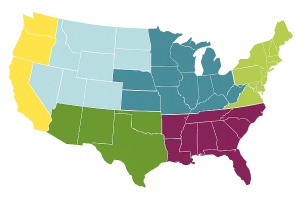Bearded Iris Planting Guide
Posted By American Meadows Content Team on Aug 8, 2013 · Revised on Oct 3, 2025

Knowing your location helps us recommend plants that will thrive in your climate, based on your Growing Zone.
Posted By American Meadows Content Team on Aug 8, 2013 · Revised on Oct 3, 2025
Bearded Irises are some of the most popular perennials in gardens throughout the world, and we’re not surprised! The endless array of colors and sizes makes them a versatile and show-stopping element of any garden. They are loved by many because they are easy to grow, deer-resistant, they multiply each year. Some are re-bloomers, putting on a colorful show in the garden twice in one season. Here are several tips to make sure your new Irises get acclimated to your space and become a mainstay of your perennial garden!
Read on to learn more about planting Bearded Irises:
Bearded Iris (Iris germanica) is a member of the genus, Iris, named after the Greek goddess of the rainbow. As the myth goes, when the gods wanted to communicate with humans, they sent Iris, who arrived with golden wings. As she stepped to earth, colorful flowers sprung forth. It’s almost hard to imagine a better name for this kaliedoscopic species! With thousands of colorful combinations, Bearded Iris is one of the most popular garden perennials. With endless choices of color, texture, pattern, and form, this flower opens the doors for garden creativity.
To communicate clearly about Bearded Iris, it’s helpful to know a little nomenclature.
Bearded Iris comes in several size ranges with differing bloom times.
Actual bloom times will vary, depending on the weather. Each flowering stem will hold several buds that will come into bloom sequentially, usually lasting 3-5 days. Once it is finished, simply snap it off with your fingers to keep a clean look and to keep more flowers coming. After all the buds have bloomed, cut the stem back near ground level.
Bearded Iris prefer at least 6-8 hours of sunlight a day. In hot climates (zones 8-11), they will tolerate 4-6 hours of sun. Make sure your Iris get some shade during the day in hotter climates. Bearded Iris prefer to be planted in well-drained soil. To improve drainage, they can be planted on a slope or in a raised bed.
Your Bearded Iris roots/rhizomes will arrive with the foliage trimmed from the past season's growth and starting to turn brown. The foliage can be trimmed when you plant, but leave at least a few inches of old foliage on the rhizome. It will be replaced next spring with deep green leaves.
What exactly is a Rhizome, anyway? The rhizome is the horizontal stem from which certain types of plants grow. Rhizomes are known for their ability to spread rapidly.

Step 1: Build up a small mound of soil in the center of the planting hole. As long as you have well-drained soil, Bearded Iris should thrive in your garden.
Step 2: Center the rhizome in the mound, roots down, and then bury it about 75%, leaving the top exposed. We recommend planting 12-24 inches apart, as planting too close together results in poor flowering. Plant rhizomes at the surface of the ground. The tops of the rhizomes should be visible; be sure to spread the roots out below the soil. The most common mistake made when planting Bearded Iris is planting them too deeply, which can result in few or no flowers.
Step 3: Firm the soil around the roots. Newly planted rhizomes should be watered thoroughly. This helps to remove any air pockets in the soil and gives Iris a better chance of strong growth.
The most common mistake made when planting Bearded Iris is planting them too deep. Planting too deep will result in few or no flowers.
After 3 to 5 years, Iris generally become crowded and should be divided. Iris can be divided at any time, but many growers prefer to divide 4 to 6 weeks after the flowering period.
Basic Steps to Divide
Step 1: Cut the leaves to one-third their length.
Step 2: Dig the clump of Iris up. Wash Soil off with a hose.
Step 3: Cut rhizomes apart so that each section has at least one healthy fan of leaves and firm, white roots. Older rhizomes should be discarded since they have limited flowering capacity. (New growth will protrude off an older rhizome from the side.)
Many new hybrid Bearded Iris are offered as rebloomers. This means the Iris will bloom at its usual bloom time in the spring, and then come into bloom again at the end of the season, towards fall. The plant will grow new fans of leaves, putting up fresh flowering stems. It’s important to note that reblooming is not guaranteed and can be affected by location, sunlight and even the weather.
Reblooming Bearded Irises grow faster than regular irises, so unlike the standard bearded iris, you'll need to divide them more often. To prevent overcrowding, divide re-blooming iris every 2 to 3 years, take only the outside rhizomes of the plant. Leave the healthy older portions of the plant intact. Replant the small rhizomes 12 to 18 inches apart.
Rebooming Bearded Irises are not always guaranteed to bloom. It often depends on geographic location, soil, and climate conditions. Reblooming Bearded Irises can also vary from year to year. They are heavy feeders, requiring a little more water and fertilizer because they need an extra boost to flower again. Re-bloomers require a little more care than the standard bearded iris but are worth the effort.
To learn more about the different varieties of Irises, please read our in-depth article: All About Irises.


